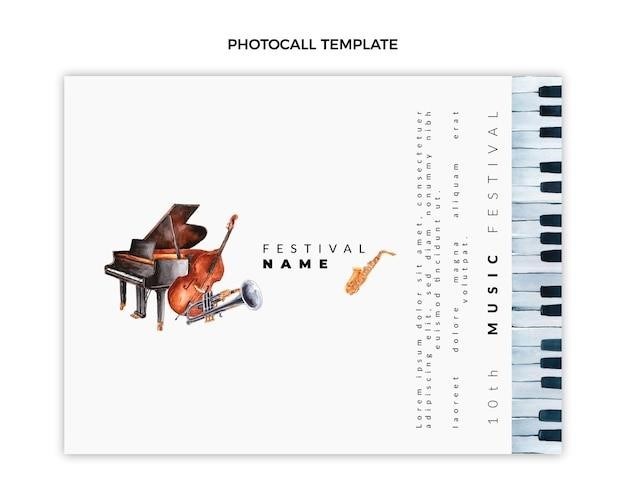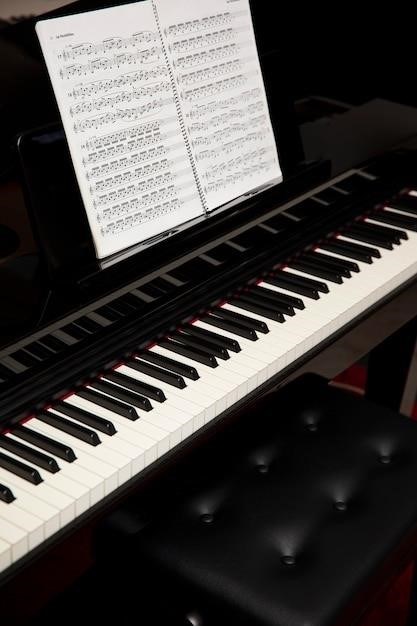Jazz Chord Progressions for Piano⁚ A Comprehensive Guide
This guide explores fundamental and advanced jazz piano chord progressions, offering downloadable PDF resources with analyses of common structures like ii-V-I and I-VI-II-V, plus practical exercises and links to helpful online tutorials and sheet music.
Understanding Basic Jazz Chords
Jazz harmony builds upon fundamental chord types, extending beyond simple major and minor triads. Mastering seventh chords—major seventh (maj7), minor seventh (min7), dominant seventh (7), half-diminished (ø), and diminished (o)—is crucial. These chords form the foundation of most jazz progressions. Understanding their construction (intervals from the root) and function within a key is essential. For instance, a dominant seventh chord creates a strong pull towards the tonic (I chord). Practice building these chords in various inversions (different bass notes) to enhance your voicings and create a more sophisticated sound. Resources like PDF chord charts can greatly assist in memorization and understanding these fundamental building blocks. Many websites offer free PDFs detailing these chord types and their inversions. Explore these resources to solidify your understanding of basic jazz chords.
Common 7th Chords in Jazz
Seventh chords are the backbone of jazz harmony. Understanding their variations is key to navigating jazz progressions. The major 7th chord (maj7) adds a major seventh interval above the root, creating a bright, joyful sound. The minor 7th chord (min7) uses a minor seventh, resulting in a more somber tone. The dominant 7th chord (7) features a major seventh, creating a strong pull towards the tonic. Half-diminished (ø) and diminished (o) chords add further color and complexity, often used as passing chords or to create unexpected harmonic twists. Many free PDFs online provide detailed explanations and diagrams of these chords. Learning to identify these chords by ear and to construct them on the piano is vital. Practice building each type in different inversions to develop smooth and sophisticated voicings. These resources offer visual aids and exercises to strengthen your understanding of these crucial chord types.
Essential Chord Voicings for Piano
Effective chord voicings are crucial for a rich and expressive jazz piano sound. Closed voicings, where all chord notes are close together, offer a compact and intimate feel, often used in ballads. Open voicings, with notes spread across a wider range, create a more spacious and airy texture, ideal for up-tempo numbers. Drop 2 voicings, where the seventh is placed below the root, add a distinctive jazzy flavor. Inversions, changing the bass note, provide harmonic variety and rhythmic interest. Experiment with different voicings to find what best suits the style and mood of the music. Many online resources and PDF guides illustrate various voicing techniques, providing examples in different contexts. Mastering these voicings allows for greater control over the overall sound and texture of your jazz piano playing, enhancing your ability to create compelling harmonic landscapes.

Analyzing Popular Jazz Chord Progressions
This section delves into common jazz chord progressions, exploring their structures, harmonic functions, and applications in various musical contexts, supported by downloadable PDF examples.
The ii-V-I Progression⁚ A Foundation
The ii-V-I progression, a cornerstone of jazz harmony, forms a fundamental building block for countless standards. This ubiquitous sequence, found in virtually every key, features a minor ii chord (supertonic), a dominant V chord (dominant), resolving to a major or minor I chord (tonic). Understanding its function is crucial for any aspiring jazz pianist. The ii chord creates a sense of anticipation, leading naturally to the dominant V chord’s strong pull towards the tonic I chord. Mastering voicings, inversions, and substitutions within this progression unlocks a world of harmonic possibilities. Numerous online resources offer PDF downloads containing detailed analyses and exercises on this progression, allowing for focused practice and improvement. Explore these resources to enhance your understanding and proficiency with this essential jazz building block. These PDFs often include chord diagrams and lead sheets, facilitating practical application and aiding in memorization.
The I-VI-II-V Progression⁚ Adding Color
Expanding beyond the basic ii-V-I, the I-VI-II-V progression introduces a sophisticated harmonic twist. Beginning on the tonic (I), it moves to the submediant (VI), creating a gentler, more melancholic feel compared to the direct ii-V-I approach; The progression then continues to the supertonic (II) before resolving to the dominant (V), ultimately leading back to the tonic (I) or another section. This progression’s flexibility allows for varied moods and rhythmic approaches, making it a valuable tool for improvisational solos and composition. Many jazz piano method books and online resources provide detailed explanations and examples of this progression in various keys. These resources frequently include downloadable PDF files with chord voicings, inversions, and suggested rhythmic patterns, enriching the learning experience and improving practical application. Exploring these materials will help unlock the full expressive potential of this richer harmonic journey.
Beyond the Basics⁚ More Advanced Progressions
Once comfortable with foundational progressions, exploring more complex structures unlocks a new level of jazz piano artistry. Advanced progressions often incorporate altered dominants, secondary dominants, and substitutions to create unexpected harmonic twists and turns. These techniques add color and complexity, pushing beyond simple diatonic movement. Resources like comprehensive jazz theory books and online courses delve into these advanced concepts. Many offer downloadable PDF workbooks containing detailed examples and exercises. These PDFs often include various chord voicings and inversions, showcasing how these advanced progressions function within a musical context. By studying these resources and practicing regularly, pianists can develop a sophisticated understanding of advanced harmony, allowing for creative and expressive improvisation and composition.
Resources for Learning Jazz Piano
Numerous online resources, books, and applications offer valuable insights into jazz piano, including downloadable PDFs containing chord progressions, scales, and exercises to enhance your skills.
Free Jazz Piano Sheet Music and PDFs
The internet offers a wealth of free resources for aspiring jazz pianists. Websites and online communities provide downloadable PDF files containing a vast collection of jazz chord progressions, meticulously arranged for various skill levels. These PDFs often include detailed analyses of chord voicings, inversions, and functional harmony, making them invaluable learning tools. Many resources offer sheet music for popular jazz standards, allowing you to practice applying the progressions in real-world contexts. Some websites even offer video tutorials alongside their PDF sheet music, providing a comprehensive multimedia learning experience. This readily available material significantly reduces the financial barrier to entry for those wishing to delve into the intricacies of jazz piano. Remember to check licensing terms before using any material for commercial purposes. Free jazz piano sheet music and PDFs are an excellent starting point for building a strong foundational understanding of jazz harmony and improvisation.
Recommended Books and Applications
Several excellent books delve into the intricacies of jazz chord progressions and their application on the piano. These often include detailed explanations of theory, practical exercises, and analyses of famous jazz standards. Look for titles focusing on jazz harmony, chord voicings, and improvisation techniques. Many reputable authors have published comprehensive guides, offering a structured approach to learning. In addition to books, numerous applications are available for smartphones and tablets. These apps often feature interactive exercises, chord progression generators, and playback functionalities, providing a dynamic learning environment. Some applications focus on ear training, helping you recognize chord progressions by ear, while others concentrate on building your vocabulary of jazz voicings. Pairing a well-structured textbook with a supportive application can create a potent learning strategy. Consider user reviews and features when selecting an application that best suits your learning style and goals.
Online Courses and Tutorials
The internet offers a wealth of free and paid online resources dedicated to mastering jazz piano chord progressions. Numerous platforms, such as YouTube, Coursera, and Udemy, host video tutorials covering various aspects of jazz harmony, from basic chord structures to advanced voicing techniques. These often include downloadable PDF materials supplementing the video lessons, providing additional exercises and practice material. Many online courses offer structured curricula, guiding you through the fundamental concepts and progressively introducing more complex progressions. Some platforms allow interaction with instructors and fellow students, fostering a collaborative learning environment. While free resources are readily available, paid courses often provide more structured content, personalized feedback, and access to exclusive materials. When choosing an online course, consider the instructor’s credentials, student reviews, and the overall curriculum to ensure it aligns with your learning goals and experience level. Remember to evaluate the quality and reliability of the source before committing significant time or resources.

Practical Application and Exercises
Apply learned progressions to jazz standards, practicing in various keys. Develop improvisational skills by creating variations and soloing over common chord changes. Downloadable PDFs with exercises can aid this process.
Practicing Chord Progressions in Different Keys
Mastering jazz piano necessitates proficiency across all twelve keys. Begin by selecting a fundamental progression, such as the ubiquitous ii-V-I, and meticulously practice it in C major. Once comfortable, transpose to other keys, focusing on the relative minor keys as well. Utilize readily available PDF resources that offer chord charts in various keys. These resources often include diagrams and fingerings optimized for piano. This methodical approach builds muscle memory and reinforces theoretical understanding. Don’t rush; accuracy and fluidity are paramount. Gradually increase tempo as your comfort level grows. Regular practice, even in short bursts, yields significant improvement. Remember to incorporate both hands concurrently, developing smooth transitions between chords. The goal is seamless execution and musical expression, not merely technical accuracy;
Developing Improvisational Skills
Improvisation is the heart of jazz piano. Start by focusing on scales and arpeggios related to the chords in your chosen progression. Many PDF resources offer exercises to build this skill. Practice playing scales over individual chords, then entire progressions. Experiment with different rhythms and melodic ideas. Listen to recordings of accomplished jazz pianists and try to emulate their phrasing and articulation. Don’t be afraid to make mistakes; improvisation is a process of exploration and discovery. Record yourself playing and critically analyze your performance, identifying areas for improvement. Gradually increase the complexity of your improvisations, incorporating passing tones, chromatic approaches, and altered dominant chords. Consider incorporating blues scales and pentatonic scales for added flavor. Remember that effective improvisation requires a solid foundation in music theory and a deep understanding of harmony. Regular practice and dedicated listening are essential to developing your improvisational abilities.
Applying Progressions to Jazz Standards
Numerous jazz standards utilize common chord progressions. Many readily available PDF resources provide chord charts for popular jazz tunes, allowing you to analyze their harmonic structures. Begin by selecting a simple standard with a familiar progression, such as a blues in 12 bars. Practice playing the chords accurately and rhythmically. Once comfortable, try substituting different voicings for the same chords to add variety and color. Next, incorporate the improvisational techniques you’ve developed, focusing on creating melodic lines that complement the underlying harmony. Experiment with different rhythmic approaches, such as swing and shuffle feels. As your confidence grows, tackle more complex standards with more intricate chord changes. Listen carefully to recordings of your favorite jazz pianists playing these standards to gain insight into their approaches and interpretations. The ability to apply learned progressions to real-world jazz standards demonstrates a practical understanding of jazz harmony.


